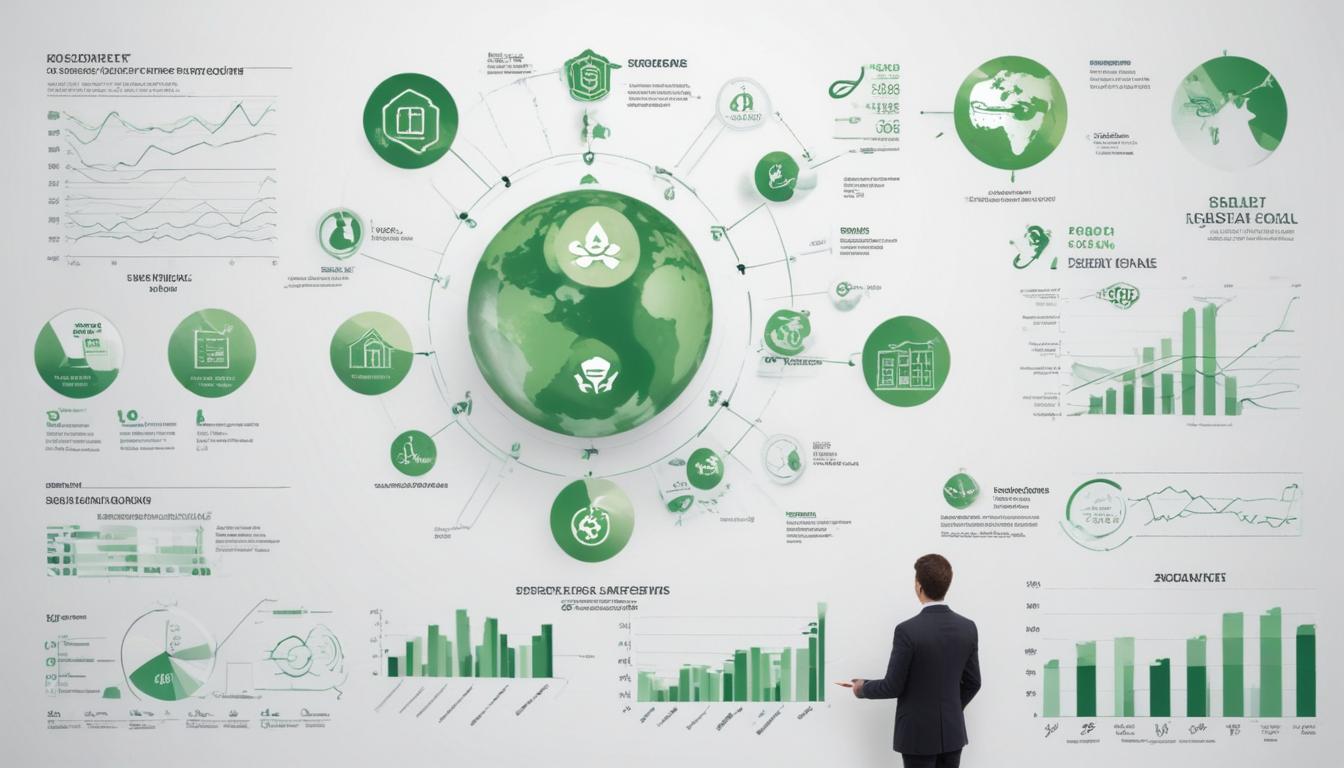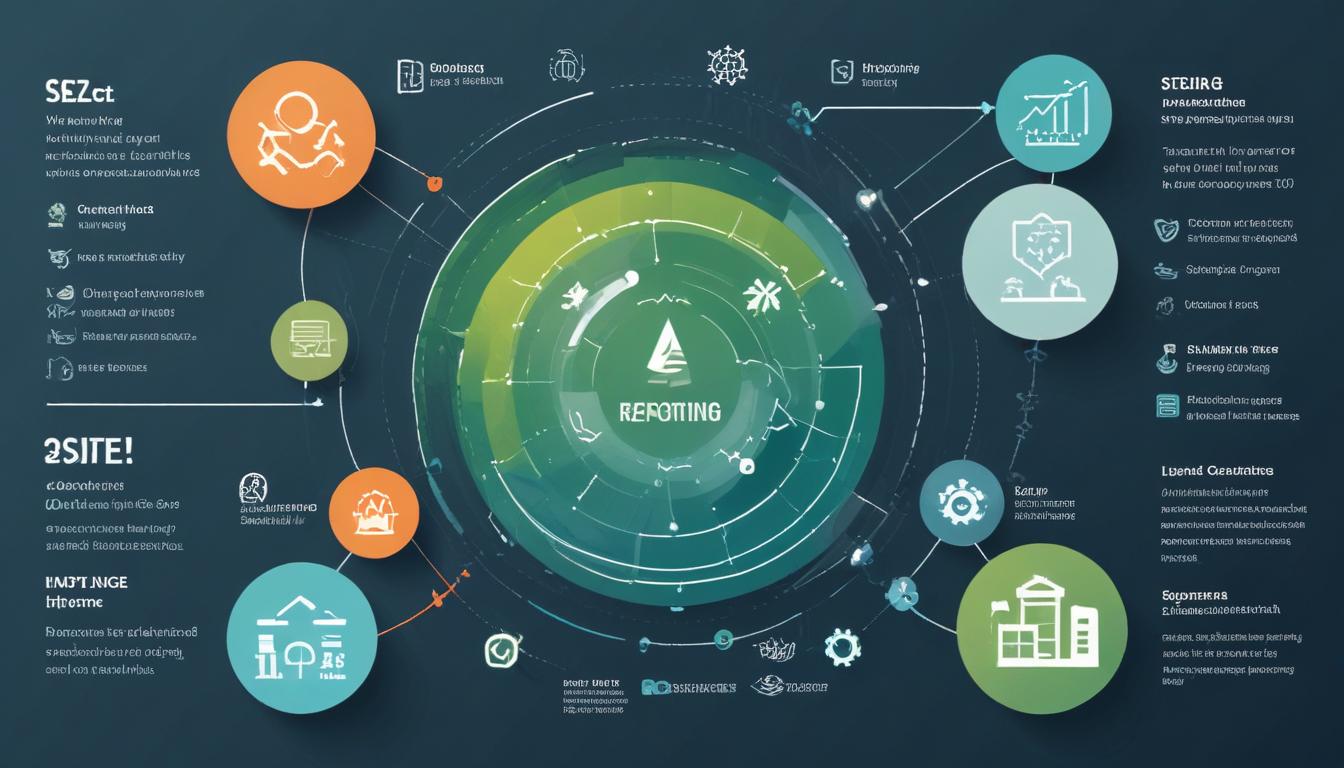Understanding the essentials of esg reporting for businesses
ESG reporting involves the disclosure of a company’s environmental, social, and governance performance, which is essential for enhancing transparency, attracting investments, and ensuring compliance with evolving regulatory standards.
ESG reporting is becoming increasingly vital for businesses aiming to enhance their sustainability efforts. But what does it involve and why should you care? Let’s dive into the essentials of ESG reporting and explore its impact on your company’s reputation.
What is ESG reporting?
ESG reporting refers to the disclosure of a company’s environmental, social, and governance performance and practices. This reporting is increasingly important as stakeholders demand more transparency regarding corporate behavior and its impact on society and the planet. By providing such reports, companies can showcase their commitment to sustainability and ethical governance.
One of the main components of ESG reporting is the environmental aspect, which includes information on a company’s carbon footprint, waste management, and resource conservation efforts. Addressing these factors is vital for companies looking to reduce their environmental impact and attract environmentally conscious investors.
The social dimension focuses on the company’s relationships with employees, suppliers, customers, and the communities in which it operates. It encompasses topics such as labor practices, community involvement, and customer satisfaction. Good social practices not only enhance a company’s reputation but also contribute to a more loyal customer base.
Finally, the governance aspect deals with the internal systems and processes that guide a company’s decision-making. This includes the structure of the board, executive compensation, and measures taken to prevent corruption and fraud. Effective governance practices are crucial for maintaining stakeholder trust and ensuring compliance with legal regulations.
Importance of ESG reporting for companies

The importance of ESG reporting for companies cannot be overstated. It plays a crucial role in building transparency and trust with stakeholders. In an era where consumers are increasingly concerned about sustainability, companies that prioritize ESG reporting signal their commitment to responsible management.
Investors are now looking beyond traditional financial metrics. They assess a company’s ESG practices to gauge long-term viability. By providing clear and comprehensive ESG reports, companies can attract a broader pool of investors who are aligned with sustainable investment principles.
Moreover, effective ESG reporting can enhance a company’s reputation. Businesses that disclose their sustainability efforts often see increased brand loyalty and customer satisfaction. Customers today tend to favor companies that demonstrate social responsibility and ethical governance, leading to a competitive advantage in the marketplace.
Another key factor is regulatory compliance. As governments worldwide implement stricter regulations regarding corporate transparency and environmental impact, companies that adopt robust ESG reporting frameworks are better positioned to meet these requirements. This proactive approach can help avoid fines and legal issues, ensuring smooth operations and safeguarding company assets.
In summary, ESG reporting is a fundamental aspect of modern business strategy, aligning corporate goals with societal expectations and enhancing overall sustainability practices.
Key components of successful ESG reporting
The key components of successful ESG reporting are essential for companies aiming to present their sustainability efforts effectively. Transparency stands out as a pivotal element, ensuring that stakeholders have access to relevant and accurate information regarding a company’s environmental impact, social practices, and governance structures. Companies must prioritize clear communication to build trust.
Another critical aspect is the consistency of reporting. Companies should follow established frameworks such as the Global Reporting Initiative (GRI) or Sustainability Accounting Standards Board (SASB). Adhering to these standards helps ensure that reported data is comparable and reliable, facilitating investor assessment.
The integration of quantitative and qualitative data is also vital. While numbers illustrate performance metrics—like carbon emissions or employee diversity—qualitative data provides context, such as policies or initiatives aimed at improving outcomes. This balanced approach enriches the narrative and highlights a company’s commitment to ESG values.
Lastly, engaging with stakeholders is fundamental. Companies should seek feedback from investors, customers, and employees when crafting their reports. This engagement demonstrates accountability and a genuine commitment to addressing stakeholder concerns. By incorporating these components, organizations can enhance their ESG reporting and effectively highlight their progress.
How to develop an effective ESG reporting framework

Developing an effective ESG reporting framework requires strategic planning and a methodical approach. First, understanding the regulatory landscape is crucial. Companies must familiarize themselves with the guidelines and standards from organizations like the Global Reporting Initiative (GRI) and the Sustainability Accounting Standards Board (SASB). This ensures that their reports align with best practices and legal requirements.
Next, organizations should engage with stakeholders to identify relevant issues to report on. Involving investors, customers, and employees in this process helps to address their concerns and demonstrates a commitment to accountability. Surveys and focus groups can be useful in gathering this feedback.
A robust data collection process is essential for accurate reporting. Companies should establish clear methodologies for gathering quantitative and qualitative data. This may involve setting up metrics for tracking environmental impact, workforce diversity, and governance practices. Data integrity is paramount, as stakeholders rely on this information to assess the company’s commitment to ESG principles.
Finally, regular review and improvement of the ESG framework is vital. Companies should assess their performance against established goals and benchmarks, adjusting their strategies accordingly. Continuous improvement not only enhances credibility but also drives long-term sustainability initiatives within the organization.
Best practices for ESG data collection
Implementing best practices for ESG data collection is essential for accurate and reliable reporting. First, companies should establish a clear data governance framework. This framework defines who is responsible for data collection, management, and oversight. Assigning specific roles ensures accountability and helps maintain high data quality.
Using consistent metrics and standards is crucial. Organizations should align their data collection methods with established frameworks like GRI or SASB. This alignment allows for more straightforward comparisons over time and enhances the credibility of the reports.
Another important practice is to utilize technology and tools for data collection. Advanced software solutions can automate data gathering, thereby reducing errors and saving time. By integrating data management systems, companies can streamline the process and enhance accuracy.
Furthermore, regular training and education for staff involved in data collection should not be overlooked. Ensuring that all team members understand ESG principles and reporting requirements fosters a culture of compliance and diligence. This investment in human capital can lead to better data quality and improved reporting outcomes.
Finally, ensure continuous review and improvement of the data collection process. Periodically evaluate the effectiveness of data sources and collection methods to identify areas that need enhancement. This iterative approach ensures that the data remains relevant and accurate.
Common challenges in ESG reporting

Many companies face common challenges in ESG reporting that can hinder their ability to provide clear and accurate information. One significant challenge is the lack of standardized metrics. Different frameworks and guidelines can lead to inconsistencies in reporting, making it difficult for stakeholders to compare performance across companies.
Another major hurdle is data collection and quality. Gathering reliable data on environmental impact, social practices, and governance metrics can be complex and time-consuming. Companies often struggle with data silos, where information is dispersed across various departments, hampering cohesive reporting.
Moreover, the evolving regulatory landscape poses a challenge. As governments and organizations implement new regulations regarding sustainability disclosures, companies must continuously adapt their reporting practices. Keeping up with these changes can strain resources and lead to compliance risks.
Additionally, many companies face internal resistance to change, particularly when it comes to adopting new reporting processes or technologies. Employees may be accustomed to traditional reporting methods, resulting in challenges when transitioning to more comprehensive ESG practices.
Finally, engaging stakeholders effectively to meet their expectations and feedback is often overlooked. Companies must actively seek input to ensure that their ESG reporting addresses stakeholder concerns and demonstrates accountability.
Understanding regulatory requirements for ESG reporting
Understanding regulatory requirements for ESG reporting is essential for companies aiming to comply with legal standards and enhance transparency. Regulations vary significantly by region and industry, making it crucial for organizations to stay informed about the specific guidelines applicable to them. For example, in the European Union, the Non-Financial Reporting Directive (NFRD) mandates that large companies disclose relevant non-financial information, covering environmental and social impacts.
In the United States, the Securities and Exchange Commission (SEC) increasingly emphasizes ESG disclosures, urging public companies to report on their climate-related risks. Companies must grasp these evolving requirements to avoid potential legal pitfalls and penalties associated with non-compliance.
Moreover, numerous frameworks provide guidance on ESG reporting, including the Global Reporting Initiative (GRI) and the Sustainability Accounting Standards Board (SASB). These frameworks help organizations structure their reports, ensuring that they meet both regulatory expectations and stakeholder needs. By aligning their reporting processes with these standards, companies can improve their credibility and attractiveness to investors.
An additional factor to consider is the ongoing changes in regulatory landscapes as governments worldwide respond to growing concerns about climate change and corporate responsibility. Organizations must establish processes to regularly review and adapt their reporting practices to maintain compliance with new regulations.
Real-world examples of successful ESG reporting

Real-world examples of successful ESG reporting provide valuable insights into best practices and effective strategies. Companies such as Unilever have set benchmarks by integrating sustainability into their core business objectives. Their transparency in reporting environmental impacts, social contributions, and governance practices demonstrates a commitment to accountability, making them a leader in ESG initiatives.
Another notable example is Microsoft, which has established clear goals for carbon neutrality by 2030. Their ESG reports detail progress toward these targets, including achievements in renewable energy usage. By outlining measurable targets and progress, Microsoft inspires confidence among investors and customers regarding their sustainability commitments.
Apple Inc. also excels in ESG transparency, frequently publishing detailed reports on environmental initiatives, labor practices, and privacy standards. Their focus on sustainability not only highlights their ethical considerations but also enhances brand loyalty among environmentally conscious consumers.
Moreover, the food giant Nestlé has made strides by addressing water usage and sustainable sourcing in its ESG reporting. By sharing these initiatives, they communicate responsibility and attract eco-conscious stakeholders who value sustainability.
These examples illustrate that effective ESG reporting not only meets regulatory requirements but also enhances brand reputation, attracts investment, and fosters long-term relationships with stakeholders.
Tools and technologies for ESG reporting
Tools and technologies for ESG reporting play a vital role in streamlining data collection, analysis, and presentation. Software solutions designed specifically for ESG reporting help organizations gather relevant data efficiently. For instance, platforms like Enablon and FigBytes offer comprehensive tools that facilitate the tracking of sustainability metrics and compliance with regulations.
Data management is another crucial aspect. Companies can utilize cloud-based technologies for real-time data accessibility and collaboration across departments. This ensures that all relevant teams have access to the same accurate data, significantly improving the reliability of reporting.
Moreover, integrating business intelligence (BI) tools can enhance the analysis of ESG data. Software like Tableau and Power BI can visualize complex data in user-friendly formats, making it easier for stakeholders to understand ESG performance. Effective data visualization accelerates decision-making processes and highlights areas needing improvement.
Artificial intelligence (AI) and machine learning are increasingly being used in ESG reporting as well. These technologies can analyze vast amounts of data quickly, identifying trends and predicting future performance. By leveraging these advanced technologies, companies can stay ahead of regulatory requirements and make informed strategic decisions regarding sustainability.
The future of ESG reporting: Trends and predictions

The future of ESG reporting is poised for significant evolution, driven by emerging trends and changing stakeholder expectations. One notable trend is the increasing demand for real-time reporting. Stakeholders, including investors and consumers, are insisting on more immediate insights into a company’s sustainability performance. This shift pushes companies to adopt advanced technologies that facilitate quicker data collection and analysis.
Another key trend is the integration of artificial intelligence (AI) in ESG reporting processes. AI can analyze vast datasets efficiently, providing deeper insights and identifying sustainability risks and opportunities that might otherwise go unnoticed. Consequently, organizations will increasingly rely on AI tools to enhance their reporting accuracy and effectiveness.
Moreover, the push for standardization in ESG metrics will continue to grow. Regulatory bodies and industry groups are working towards establishing universally accepted frameworks, which will simplify comparisons between companies and enhance transparency. This trend will make ESG reporting more reliable and guide corporate strategies.
As awareness of social issues rises, there will be a heightened focus on social impact reporting. Consumers and investors will expect organizations to not only disclose environmental performance but also report on their effects on communities, diversity, and labor practices. This holistic approach will shape the way companies present their ESG narratives moving forward.
Frequently Asked Questions
What is ESG reporting and why is it important?
ESG reporting involves disclosing a company’s environmental, social, and governance practices, which is essential for transparency and accountability towards stakeholders.
How can companies improve their ESG reporting practices?
Companies can improve their ESG reporting by adopting standardized frameworks, using advanced data collection tools, and engaging with stakeholders to ensure transparency.
What challenges do organizations face in ESG reporting?
Organizations often struggle with inconsistent metrics, data quality, compliance with evolving regulations, and internal resistance to changing reporting processes.
How does technology enhance ESG reporting?
Technology, especially AI and data analytics tools, facilitates faster data collection, deeper analysis, and improved visualization, leading to more accurate and impactful ESG reports.
What trends are shaping the future of ESG reporting?
Trends include the demand for real-time reporting, increased focus on social impact, the integration of AI, and the push for standardized metrics across industries.
How can companies measure their social impact effectively?
Companies can measure their social impact by setting clear metrics related to community engagement, diversity, employee well-being, and other relevant social factors.
